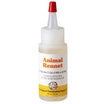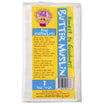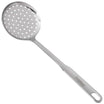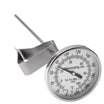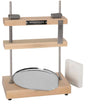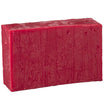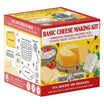
Brick Cheese Recipe
-
Yield
4 Pounds
-
Aging Time
~3 Months
-
Skill Level
Intermediate
-
Author
Jim Wallace

Ingredients
Total price for selected items: Total price:
Instructions
-

Acidify & Heat Milk
Begin by heating 4 gallons of milk to 88°F (31°C). You do this by placing the milk in a pot or sink of very warm water. If you do this in a pot on the stove, make sure you heat the milk slowly and stir it well as it heats.
Once the milk is at 88F the culture and b.linens can be added. To prevent the powder from caking and sinking in clumps, sprinkle the powder over the surface of the milk and then allow about 2 minutes for the powder to re-hydrate before stirring it in.
Then allow the milk to ripen for 10 min. (this is a very short time because we need a very slow acid development to produce a sweet cheese).
-


Coagulate with Rennet
Then add about 3/4 tsp (3.7 ml) of single strength liquid rennet.
The milk now needs to sit still for 30 minutes while the culture works and the rennet coagulates the curd. You will notice the milk beginning to thicken in about 15 minutes but wait 30 minutes until you see a good curd.
The thermal mass of this milk should keep it warm during this period. It is OK if the temperature drops a few degrees during this time.
-


Cut Curds & Release Whey
Begin by cutting the curd into 3/4-1 inch squares, then allow this to rest 2-3 minutes for the cuts to heal. The curd will be very soft and this will prepare for a more even cut size.
Then, cut the curd to 3/8" to 1/2" pieces as evenly as possible. I use a large whisk with thin wires which I have expanded to a globe shape for this as shown below. Rest again about 5 minutes giving it a very gentle stir every minute or so to keep from matting.
The curd remains quite soft and tends to slump back into a single mass at this point, so careful stirring is important until it firms up more.
The whey should have begun to rise, so now stir gently for 10 minutes (the curd is still quite soft at this point). The curd will begin to firm up during this phase.
-




Cook the Curds
Now it is time to begin drying out the curds. This will be done by increasing the heat slowly from 88-100°F over 45-60 minutes (the longer time for a drier curd). A slow and constant stir should keep the curds from breaking while encouraging the whey to be released.
During the cooking (scald), the curds will begin to take on a firmer look/feel and will remain separate more noticeably than during the initial cut and stir.
-



Remove Whey & Wash Curds
This step is very important in slowing the acid production required for the sweet cheese body.
Allow the curds to settle and remove 25% of the original milk volume (1 gal) as whey (this will deprive the bacteria of lactose and slow its acid development).
Immediately, add back cool water at 65°F until the curd temperature drops to 85°F (this will slow the bacteria even further with the cooler curd).
Then continue stirring until the curd is firm enough to mold. The final curds should be cooked well through and should be examined to make sure that enough moisture has been removed. A broken curd should be firm throughout and the curds should have a moderate resistance when pressed between the fingers.
Too much moisture and the cheese will develop late acid and a pasty texture in the aging room.
Too little moisture and the cheese will not consolidate well or ripen correctly due to lack of moisture for enzyme transport.
When this point is reached, the curds can be allowed to settle under the whey and then the whey can be removed down to the curd level again.
-



>Molding & Pressing
The curds can now be transferred to a sanitized mold sitting on a draining mat.
- They should be allowed to drain for 15 minutes with no weight.
- Then turn (#1) at 15 min.
- Turn again (#2) and add 5 lbs weight (2.5 qts water) for the traditional brick mold of 5"x10" (50"sq). Our large cheese mold (M2) is about this same size.
Yes, I realize my form above is not a traditional Brick shape but it's what I have here and it works quite well.
Note: If making a smaller 2 lb. cheese and using the basket mold, it has a surface area of about 20"sq. so use 2 lbs of weight or about 1 qt of water as weight.
Only apply the weight for 2-3 hrs then allow the cheese to sit in molds overnight with no weight. Turn the cheese again in the mold when removing the weight.
It would be wise to place a damp cloth over this to keep the cheese from drying out. Try to keep the cheese between 70-75°F during this time.
-


Salting
You will need a saturated brine prepared for salting this cheese, find all of the details you need on brining here.
A simple brine formula is:
- 1 gallon of water
- 2.25 lbs of salt
- 1tbs. calcium chloride
- 1 tsp. white vinegar
- Bring the brine and cheese to 50-55°F before using.
The final weight of the cheese will be about 4.5 lbs
The cheese now needs to be set in the brine for about 10 hours (about 2.25 hrs per lb. of final cheese). The cheese will float above the brine surface, so sprinkle a small amount of salt on the top surface of the cheese. Flip the cheese and re-salt the surface about half way through the brine period.
At the end of the brine bath, wipe the surface and allow the cheese surface to dry a little for several hours. The surface will darken some what during this time.
-



Aging
There are two types of brick cheese that are made exactly the same until they get to the curing room:
1. Stronger and more traditional aromatic cheese
In the curing room the aged Brick is kept at 68-70°F and 90-95% moisture and is washed and rubbed daily with a light brine for 7 to 10 days. By then it should have developed a good bacterial growth on the surface and should be simply turned daily for the next 7-10 days. It is then wrapped and cold stored at 42°F until ready (2-3 months total ripening time).
2. Milder and less pungent version
This is kept in a 55°F and 90-95% humidity space for 2 days and washed daily (Widmer simply dips this cheese with no wash). This may then be dried and wrapped on the 3rd day and moved to cold storage.
Note: The light washing brine can be made up with about 1-2 tbls. salt to 1 cup of cool water. Begin with the lower dose and if other molds become a problem, increase the salt.
A good wrapping paper for this cheese is our 2 ply washed rind paper which contains a layer of sulfated parchment to control the surface growth and a poly layer to control moisture loss. Joe Widmer tells me that he wraps first with parchment paper and then with foil.
Cheese Making Supplies
Related Products
You May Also Like
















